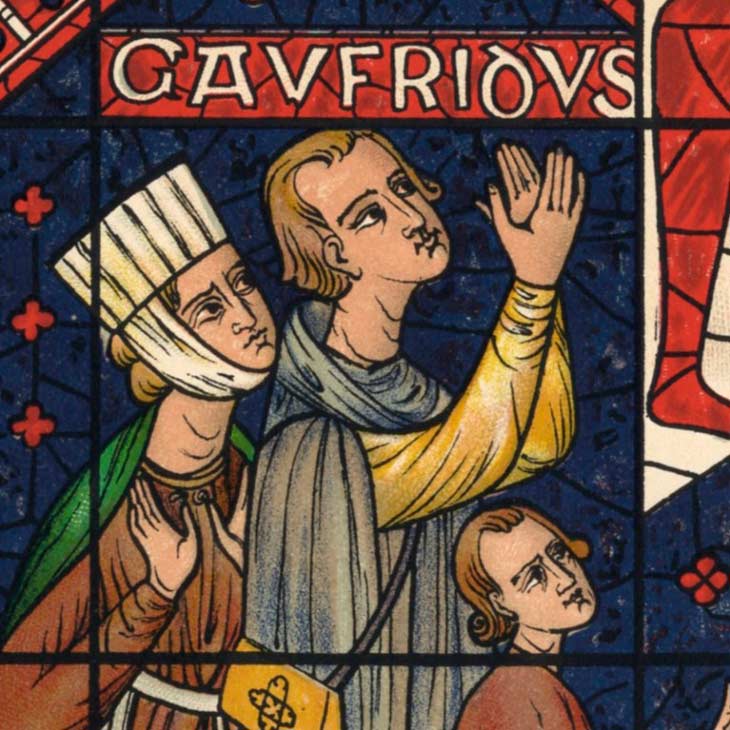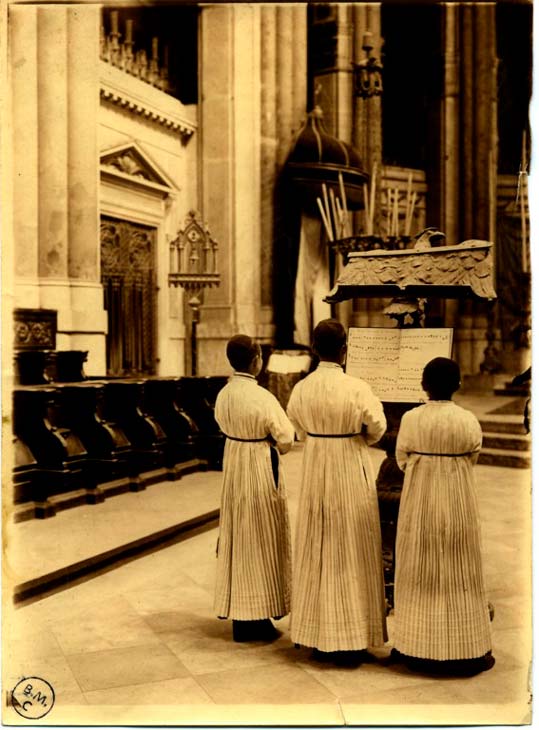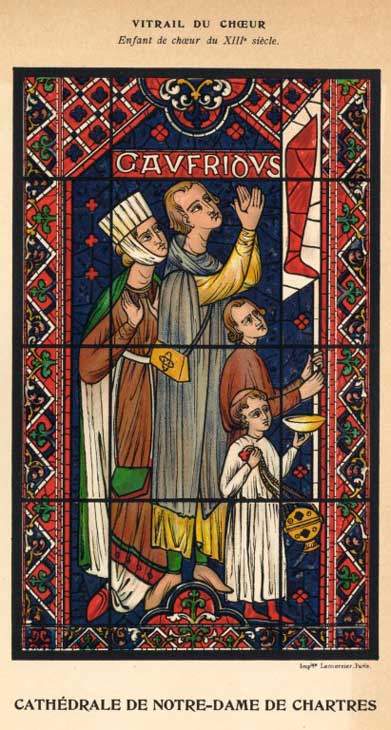
© excerpt from Abbé Clerval’s book, La Maîtrise
Our knowledge of the cathedral’s early choir school is based primarily on Abbé Clerval’s “L’ancienne Maîtrise de Notre-Dame de Chartres du V siècle à la Révolution”, Paris, 1899.
Origins
From time immemorial, people have sought harmonious voices to sing the glory of God, and naturally, schools were set up near churches to teach singing: these were the ancestors of the Maîtrises.
In Chartres, as in many cathedral parishes, a clerical school of 72 young children consecrated to God by their parents or chosen by bishops for their virtue and talent was created as early as Saint Lubin (6th century). Here, they not only studied literature, but also learned to sing God’s praises, take part in ceremonies and study.
In 1127, given the complexity of music in Chartres, a group broke away from the episcopal school and gave priority to singing: the Maîtrise was born. Composed of 6 children at its inception, it never numbered more than 12.
Organization
Children enter the Maîtrise at around age 7 and leave at around age 17.
Initially, they were taught by one master, later by two: a grammar master, who lost his predominance at the end of the 15th century to the music master. The first music master was Jean de Santander; the last, before the French Revolution, was Pierre Desvignes.
From the 14th to the 16th century, the “petits maîtrisiens”, who had to live together, changed their place of residence at least 7 times, until 1545, when a house was acquired in which they remained until the Revolution, and which still exists today, near the porte de l’Officialité (on the rue des Lisses).
The house consists of :
– a dormitory converted into individual cells in 1773
– a kitchen
– a study room
– a cabinet
– an infirmary
– a room for the music master
– a few rooms for the maid, visiting musicians, etc.
Music masters are carefully recruited by competitive examination. They can come from far and wide, and are sometimes well-known composers such as Nicolas Bernier (1664-1734).
Depending on the period, masters learn singing, composition and an instrument: the organ remains the principal instrument, but from 1655 the serpent and bassoon are introduced; the double bass struggles to establish itself at the end of the 17th century, and the violin makes a timid appearance in the 18th century.
Master’s costume
The religious costume of the young “maîtrisiens”, who are shaved on all major feasts, consists of :
– a cassock
– over this, an alb (which is why they are referred to as “enfants d’aubes” in some texts) which, in 1572, replaced the surplice
– a belt to cinch the alb around the waist
– as early as the 16th century, a camail for colder weather
– a small round hat (capelli), then a square hat (birreta)

© Chartres Médiatheque
The master’s schedule
The day begins at 4am. The children perform the day’s liturgical service in the cathedral choir:
– mâtines
– lauds
– prime
– Beata mass
– Obit mass
– chapter mass
– sexte
– nones
– vespers
– compline
In addition to these services, there are specific ceremonies for particular feasts or times.
Master’s study sessions are interspersed between the various times devoted to liturgy: in the morning, Latin, martyrology and catechism; in the evening, music. However, their timetable leaves them some leisure time, which they occupy by playing bowling, boules or jeu de paume. A beautiful garden is at their disposal, and every Thursday they take a trip into town, unless a liturgical ceremony requires their presence.
Death of the Maîtrise
The Revolution abolished the Cathedral Chapter on December 25, 1790.
On January 8, 1793, the municipality compared the Maîtrise’s income and expenditure, and in view of the announced deficit, decreed that it be abolished under the same conditions as before. The music master’s lodgings were sold, as were the linen and trunks in the choirmaster’s house.
On November 15, 1793, the cathedral became the Temple of Reason, and the Maîtrise ceased to exist.
Revivals
Article 1 of the Concordat of 1801 (26 messidor an IX) stipulates that “the Catholic, Apostolic and Roman religion shall be freely exercised in France”. The Maîtrise was reborn… only to disappear again in 1969 under the episcopacy of Monseigneur Michon.
But Father Hercouët, rector of the cathedral, successfully re-established it in 1980.
